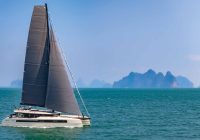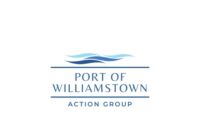By Danny Casey – Part 1
Danny Casey offers some thoughts on what the outboard of the immediate and not-too-distant future may be like, and why “trickledown” automotive technology may not always be the most logical step.
With the automotive industry currently racing towards a credible and viable alternative to the internal combustion engine (ICE) and zoning in rapidly, and maybe somewhat hastily and rashly, on an all-electric future, one would be tempted to think that the outboard industry – by virtue of the overlap and synergy with the land transport sector enjoyed by three of the major manufacturers – would not be far behind in terms of opting for an electric or even hybrid solution, but that is possibly a rather simplistic supposition at present.
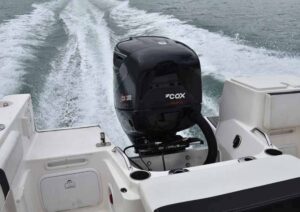
The COX 300 diesel outboard has up to 30% better fuel efficiency compared to a 300hp petrol outboard.
THE 2-STROKE: RIP OR JUST RESTING?
Before examining what technology may be waiting in the wings, one can say – well, I will say emphatically – that it will not, under any circumstances, involve any reincarnation or revamped iteration of 2-stroke technology. Firstly, let me go on the record and state that I still love, and have always loved, 2-stroke outboards (2-stroke anything, actually – even early Saabs and Eastern European cars!) – it is hard to beat the feel of frenzied, frenetic urgency as the engine spools up, making one complete power cycle with one upward and one downward stroke of the piston (all done in only one crankshaft revolution). Then there is the intoxicating, heady, addictive concoction of oil, mixed with fuel, burning off through the morning dew and the dawn, or memories of the buzzy toing and froing in the seconds before flag-drop at a boat race, with an addictive and hedonistic blue aromatic haze encroaching pungently yet sweetly on one’s nostrils. Forgive me – I was getting carried away with nostalgia from a halcyon era there…!
But, warm, fuzzy nostalgia aside, there is little reason to view the conventional 2-stroke outboard motor as anything other than noisy, smelly and inordinately thirsty. There have, of course, been progressive, innovative and much cleaner developments of 2-stroke technology, like the Orbitalderived Mercury Optimax and Tohatsu TLDI motors and other proprietary direct-injection systems like Yamaha’s HPDI, OMC’s Ficht/Ficht RAM and, latterly BRP’s E-Tec and G2 motors but, take it from me, this was deadend engineering, solely to circumvent emission-level hurdles before the major manufacturers had to bite the bullet and go all-in to develop 4-strokes. This “advanced” 2-stroke technology has been consigned to history and is now a firmly closed book.
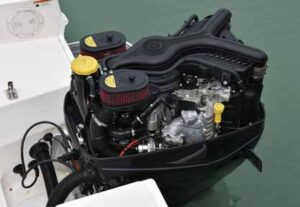
The COX 300 has a service life three times that of a conventional petrol outboard.
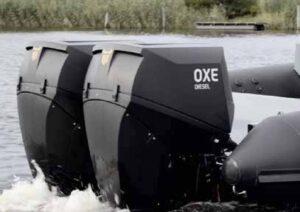
OXE diesel outboards are available from 150 300hp.
Modern boaters do not want, and will no longer accept, what is known as “total-loss lubrication”, where oil has to be added separately – regardless of how infrequently – to a remote reservoir (not a conventional “oil bath” sump). Nor do they want their olfactory senses and eyes assailed with the sharp, tangy, acrid smell of synthetic oil being burned off as part of the combustion process. BRP has, of course, stuck resolutely with DI 2-stroke technology for its new Rotax (originally Project “Ghost”) marine propulsion unit (not a conventional, vertically-oriented outboard in the true sense), so it is conceivable that they have done exhaustive market research and therefore maybe know something the rest of us don’t, but I am not the only one to believe that this product will go the way of the kerosene tractor or the Betamax cassette. This, however, is a specific subject which we can possibly examine in a separate article. Although conventional 2-stroke development is dead in the outboard segment, one would not have to travel more than a couple of hours by air from these shores to see “new” 2-strokes still being used throughout the island nations of the South Pacific. In these nations, most of which do not implement or mandate strict emissions regulations, it is still possible to buy a brand new 2-stroke in the form of the venerable Yamaha Enduro models, Mercury Sea Pros, Mariner Marathons and Tohatsu EverRuns.
Until very recently, markets like PNG, The Solomon Islands and Vanuatu were still more than 60% 2-stroke oriented, with the ubiquitous Yamaha Enduro the marine equivalent of the Toyota Hilux. These old-design 2-stroke outboards are a huge cash cow and a lucrative source of guaranteed extra income for the outboard manufacturers, as the costs for design and tooling have all been amortised decades ago. The manufacturers know, however, that the days of old-technology 2-strokes are numbered pretty much everywhere and that the day of reckoning looms. To this end, they have been steadily drip-feeding 4-strokes (often not the current iteration but cleaner technology nonetheless) into these developing markets.
As 2-strokes start to disappear from boat ramps all over this region (and they already fast becoming an endangered species on the waterways around Sydney and Auckland), all we will be left with is memories – good, indelible memories which will be the marine equivalent of actually having to get out of one’s chair to change channels on the TV. No doubt about it, then; as far as the 2-stroke is concerned, it is most emphatically RIP.
ANY MILEAGE IN DIESEL?
There is, of course, “mileage” (literally) in diesel, as well as torque, durability and reliability – but I honestly can’t see diesel outboards ever being any more than a niche product. Furthermore, I would venture as far as to say that the chances of ever seeing large numbers of them on leisure boats is about as likely as Fiji opening an alpine ski resort that would have St Moritz filing for bankruptcy.
There is no doubt that diesel is by far the safest and most stable fuel one can carry on a boat, particularly in the case of inboards or sterndrives, as there will be no explosive vapours lurking low in the bilge that could be ignited by an errant spark from a battery or shorted starter motor. However, the huge initial cost of the engine – unless it is going to be used commercially over thousands of hours – means that a leisure user will never, ever recoup the cost of purchase. There is certainly the economy factor, with some diesels yielding over 45% thermal efficiency versus about 35% efficiency in a petrol engine (i.e. the diesel engine is almost 30% more efficient), but that characteristic aside, there is little that would compel the leisure boater to spend much (a lot) more money on an engine that will never go anywhere near paying for the difference in price over a petrol engine – not to mention that, in terms of the average 100-hour leisure-boat season, petrol is still one of the cheapest ingredients one can pour into a boat.
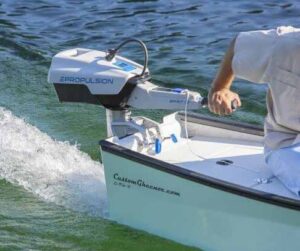
EPropulsion offer electric outboards from 3hp to 10hp
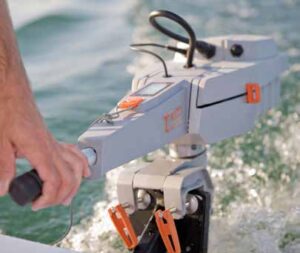
Torqeedo is one of the world leaders in electric outboards
There is undoubtedly a market – albeit in a purely commercial context – for the 150-300 hp diesel outboards by OXE of Sweden (and, latterly, Atlanta, Georgia), the CXO 300 by Cox in the UK, and the German-origin 50 hp Neander DTorque 111, but these engines will not be in the vanguard of an alternative fuel wave sweeping the outboard industry. Part of the problem is that there has been a huge consumer push-back on diesel in Europe, with the inordinately stringent (some even say unrealistic) standard of Euro 7 proposed for 2025. These regulations will take the form of vast reductions in the content of carbon monoxide (CO), total hydrocarbons (THC) and nitrogen oxides (NOx). Whilst trucks will have to make a concerted effort to comply with the Euro 7 diesel regulations, car manufacturers like BMW, Mercedes- Benz and Volkswagen realise that the writing is on the wall for diesel automotive engines and that hybrid or electric will be the only realistic avenues to follow.
If and when the lightweight, highperformance diesel engines from Europe cease to exist, there will be no platforms around which highoutput diesel outboards could be economically developed.
The UK would theoretically have been an ideal market for diesel outboards, as there had always been greatly reduced excise duty on offroad or marine diesel fuel (traditionally dyed red and latterly green), but this status has been rescinded in recent years – so now offroad/marine diesel is the same price as road fuel and there is no cost benefit to running a diesel-powered boat. Ironically, this mandate actually resulted in a substantial increase in the number of high-horsepower petrol outboards being sold in the UK, as many owners of large diesel-engine boats offloaded them once offroad diesel lost its special excise status, but they still wanted to keep boating and many bought large outboard-powered RIBs instead.
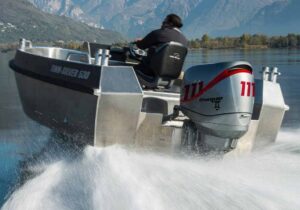
The Neander Dtorque 111 produces 50hp from a unique twin-crank-shaft turbo-charged engine.
The chances of a mainstream outboard manufacturer committing to a diesel unit are next to non-existent. Yes; Mercury does sell a commercial/ military outboard that runs on diesel fuel, but it is a multi-fuel engine that retains spark ignition. Mercury could do a full-on diesel outboard if they so wished, as they supply sterndrive units to Hyundai for the latter’s SeasAll marine diesel range and could theoretically buy the rights to one of the Hyundai power units. I think this unlikely, however. Furthermore, none of the Japanese manufacturers will touch diesel with a bargepole – Honda in particular has never had any affection for the diesel engine and the Japanese do not buy diesel cars.
There is a lot to be said for diesel outboards in NATO, military or police applications, particularly with the NATO policy mandating a single fuel type, and this same premise would apply also to the likes of superyachts (where carrying petrol for on-board toys like RIBs and PWCs has an element of risk) – but the overall adoption and acceptance of diesel outboards will be marginal and specialised. I cannot see how there will ever be enough economies of scale – in terms of volume – to make diesel outboards both affordable and more mainstream. The technology and execution are excellent but will remain the “quirky” preserve of pioneers – like those who bought diesel Peugeots and Benzes when they were curios.
Danny Casey is highly experienced, undoubtedly idiosyncratic, and immensely knowledgeable about things mechanical, new or old. His knowledge and passion are as a result of spending his whole life in or around anything power-driven – especially marine engines. His passion for boating is second to none, with his life a montage of fabulous memories from decades spent in or around water and boats, both here and in Europe. Danny has spent myriad years in the recreational marine industry in a varied career in which he has bamboozled colleagues and competitors alike with his well-honed insight.

His mellifluous Irish accent, however, has at times been known to become somewhat less intelligible in occasional attempts at deliberate vagueness or when trying to prevent others from proffering a counter-argument or even getting a word in. Frank and to-the-point, but with a heart of gold, it can be hard to convince Danny to put pen to paper to share his knowledge. Marine Business News is grateful for his contributions. Connect with Danny through LinkedIn.





